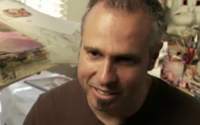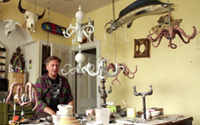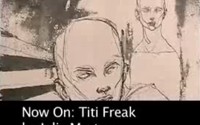“Rise Up” is one of twelve paintings in Josh Tiessen’s debut international solo exhibition, Streams in the Wasteland, at Jonathan LeVine Projects (May 4-31, 2019)
Music: “Rarefaction” by Zac Tiessen
Video Edited by Zac Tiessen
Paint Brushes provided by Princeton Artist Brush Co.
Streams in the Wasteland: “Rise Up”
Oil on Braced Baltic Birch • Framed: 58″ x 91″ x 20″ • 2018
“This painting is the sequel to an earlier work “Can These Bones Live?” both of which explore a visual interpretation of the Valley of Dry Bones vision from Ezekiel 37. This ancient book records the prophecies of Ezekiel to his fellow Jewish refugees, who have been taken by King Nebuchadnezzar from their homeland of Judah to Babylon [i]. In the vision are sun-bleached bones and skeletons, symbolic of the Jewish exile, which according to Ezekiel happened as a result of their rebellion against the Creator. God’s spirit breathes life and the bones rattle together, taking on flesh and coming back to life – an image for the hope of national resurrection, the great homecoming [ii]. In the broader context of the Bible, this vision foreshadows the promise of transformed hearts through grace, enabling the people of God to live in a new universe of justice and peace, traditionally referred to as heaven.
Often heaven is visualized as an otherworldly place where nothing much happens [iii] to wispy disembodied spirits on clouds [iv]. This painting is a musing on the resurrection, how bodily death gives rise to bodily life-after-death. Our soul makes up all of who we are, including our unique personality and ethnicity. With the historical propensity in Renaissance art to ‘white-wash’ biblical scenes, I sought to depict racially diverse figures of various ages: a young bi-racial woman, an elderly Caucasian man, and a middle-aged Indonesian lady.
The title for this painting came from the song “Still Rolling Stones” by Lauren Daigle, which also reflects the themes expressed in this work. The painting is a metaphor for transcending all that is evil in our present world, including greed, self-absorption, and racism. It expresses the longing for a world set right, where harmony will reign between the Creator, humans, and animals. Species like these Monarch Butterflies, fifteen to represent the model’s age, will flourish once again.”
–Josh Tiessen
[i] 597-571 BC in Tel Abib near the Kebar River (modern-day Iraq)
[ii] The Hebrew word ruah, can be translated as spirit, breath, or wind
[iii] Nathan Coley’s illuminated text sculpture
[iv] Plato







